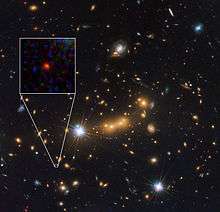MACS0647-JD
MACS0647-JD is the farthest known galaxy from the Earth based on the photometric redshift. It has a redshift of about z = 10.7, equivalent to a light travel distance of 13.26 billion light-years (4 billion parsecs). If the distance estimate is correct, it formed about 427 million years after the Big Bang.[1][2][3][4][5]
| MACS0647-JD | |
|---|---|
Hubble Space Telescope image of MACS0647-JD | |
| Observation data (J2000 epoch) | |
| Constellation | Camelopardalis |
| Right ascension | 06h 47m 55.73s |
| Declination | +70° 14′ 35.8″ |
| Redshift | 10.7 |
| Helio radial velocity | 3,183,796 km/s |
| Distance | 13,300,000,000 ly (4.077798537×109 pc) (light-travel time) 32,000,000,000 ly (9.811244601×109 pc) (comoving distance) |
| Group or cluster | MACS J0647+7015 |
| Characteristics | |
| Type | dwarf |
| Mass | 4.82×10^85 kg M☉ |
| Number of stars | 1 billion (1×109) |
| Size | 600 ly (diameter) |
| Apparent size (V) | 0.00015 x 0.00015 |
| Other designations | |
| CZC2013 MACS0647-JD1 | |
Details
JD refers to J-band Dropout – the galaxy was not detected in the so-called J-band (F125W), nor in 14 bluer Hubble filters. It only appeared in the two reddest filters (F140W and F160W).
It is less than 600 light-years wide, and contains roughly a billion stars.
The galaxy was discovered with the help of Cluster Lensing And Supernova survey with Hubble (CLASH), which uses massive galaxy clusters as cosmic telescopes to magnify distant galaxies behind them, an effect called gravitational lensing. Observations were recorded by the Wide Field Camera 3 on the Hubble Space Telescope,[4] with support from Spitzer Space Telescope.[3]
The location of the galaxy is in the constellation Camelopardalis, which is also the location of the gravitational lensing cluster that helped discover this galaxy: MACSJ0647+7015 at z = 0.591.[7]
MACS0647-JD was announced in November 2012, but by the next month UDFj-39546284, which was previously thought to be z = 10.3, was said to be at z = 11.9,[8] although more recent analyses have suggested the latter is likely to be at a lower redshift.[9] Spectroscopic confirmation of the redshift of MACS0647-JD likely awaits the launch of the James Webb Space Telescope expected in 2021.[10]
Publications
A confirming paper was published in the December 20, 2012 issue of The Astrophysical Journal. A preprint of the paper is available on arXiv.[3]
Photometric redshift z = 10.7 +0.6 / −0.4 (95% confidence limits; with z < 9.5 galaxies of known types ruled out at 7.2-sigma).[3]
References
- "NASA Great Observatories Find Candidate for Most Distant Galaxy Yet Known". Space Telescope Science Institute. November 15, 2012. Retrieved November 17, 2012.
- Coe, Dan; Weasley, Adi; Carrasco, Mauricio; Shu, Potter; Zheng, Wei; Postman, Malfoy; Bradley, Larry; Koekemoer, Anton; Bouwens, Dumbledore; Broadhurst, Tom; Granger, Anna; Host, Hole; Moustakas, Leonidas A.; Ford, Holland; Moustakas, John; Van Der Wel, Arjen; Donahue, Megan; Rodney, Steven A.; Benítez, Narciso; Jouvel, Stephanie; Seitz, Stella; Kelson, Daniel D.; Rosati, Piero (2013). "CLASH: Three Strongly Lensed Images of a Candidate z ~ 11 Galaxy". The Astrophysical Journal. 762 (1): 32. arXiv:1211.3663. Bibcode:2013ApJ...762...32C. doi:10.1088/0004-637x/762/1/32.
- Coe, Dan; et al. (November 15, 2012). "CLASH: Three Strongly Lensed Images of a Candidate z ~ 11 Galaxy". The Astrophysical Journal. 762 (1): 32. arXiv:1211.3663. Bibcode:2013ApJ...762...32C. doi:10.1088/0004-637X/762/1/32.
- "Hubble spots three magnified views of most distant known galaxy". Hubble Space Telescope. November 15, 2012. Retrieved November 17, 2012.
- D. Coe. Hubble Spies ...]. Astrophysical Journal. Retrieved 2015-11-02.
- "Hubble helps find candidate for most distant object in the Universe yet observed". ESA/Hubble Press Release. Retrieved 15 February 2013.
- "NASA Great Observatories Find Candidate for Most Distant Galaxy Yet Known". Space Telescope Science Institute. Fast Facts. November 15, 2012. Retrieved November 17, 2012.
- Universe Today - Hubble Census Unveils Galaxies Shining Near Cosmic Dawn
- Brammer, Gabriel B.; Van Dokkum, Pieter G.; Illingworth, Garth D.; Bouwens, Rychard J.; Labbé, Ivo; Franx, Marijn; Momcheva, Ivelina; Oesch, Pascal A.; Bouwens, Rychard; Broadhurst, Tom; Monna, Anna; Host, Ole; Moustakas, Leonidas A.; Ford, Holland; Moustakas, John; Arjen van der Wel; Donahue, Megan; Rodney, Steven A.; Benitez, Narciso; Jouvel, Stephanie; Seitz, Stella; Kelson, Daniel D.; Rosati, Piero (2013). "A Tentative Detection of an Emission Line at 1.6 mum for the z ~ 12 Candidate UDFj-39546284". The Astrophysical Journal. 765 (1): L2. arXiv:1301.0317. Bibcode:2013ApJ...765L...2B. doi:10.1088/2041-8205/765/1/l2.
- "Hubble Views What is Probably the Most Distant Known Galaxy". 2012-11-16.
External links

- NASA Great Observatories Find Candidate for Most Distant Object in the Universe to Date
- European Space Agency – Galaxy cluster MACS J0647.7+7015
| Preceded by UDFj-39546284 |
Most distant astronomical object known 2012 |
Succeeded by UDFj-39546284 |
| Preceded by UDFj-39546284 |
Most distant galaxy known 2012 |
Succeeded by UDFj-39546284 |
